The intelligent cervical massager market is valued at USD 254.7 million in 2025 and is expected to reach USD 464.8 million by 2035, with a CAGR of 6.2%. From 2021 to 2025, the market grows from USD 188.5 million to USD 254.7 million, with intermediate values of USD 200.2 million, USD 212.6 million, USD 225.8 million, and USD 239.8 million. The early-stage growth follows a relatively steady upward trajectory, driven by increasing consumer interest in self-care and wellness, particularly in the context of neck pain relief and relaxation.
This period reflects a typical market adoption curve, as consumers begin to discover the benefits of intelligent cervical massagers for relieving stress, muscle tension, and cervical pain.
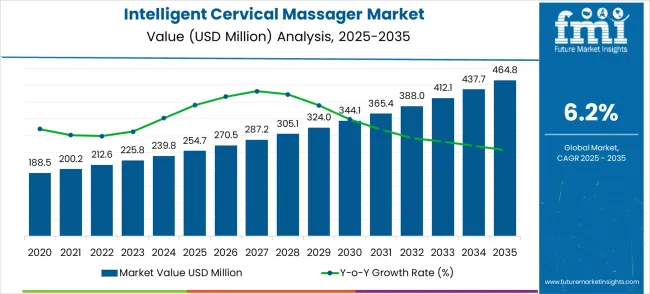
Between 2026 and 2030, the market continues to expand from USD 254.7 million to USD 344.1 million, passing through USD 270.5 million, 287.2 million, 305.1 million, and 324.0 million. During this phase, the market experiences more pronounced cyclical patterns, with seasonal demand driven by key holidays or peak wellness periods. As the massagers gain popularity, particularly among working professionals and individuals with chronic neck pain, fluctuations in demand are observed. Consumer awareness and targeted marketing campaigns contribute to periodic growth; however, demand also exhibits certain cyclical patterns based on seasonal wellness trends. By 2030, the market will reach USD 365.4 million, and from 2031 to 2035, it will continue to rise, reaching USD 464.8 million, reflecting the continued maturation of the market with more consistent growth across the years.
| Metric | Value |
|---|---|
| Estimated Value in (2025E) | USD 255 million |
| Forecast Value in (2035F) | USD 465 million |
| Forecast CAGR (2025 to 2035) | 6.2% |
Market expansion is being supported by the increasing prevalence of neck pain and cervical spine issues among working professionals, creating corresponding demand for convenient and effective at-home therapeutic solutions that can provide relief without requiring professional intervention. Modern lifestyle factors including prolonged computer usage, smartphone dependency, and sedentary work environments are contributing to widespread cervical spine problems that require regular therapeutic intervention. Intelligent cervical massagers provide the necessary therapeutic capabilities, convenience, and cost-effectiveness to address ongoing neck health needs while offering personalized treatment approaches and comprehensive wellness monitoring.
The growing emphasis on preventive healthcare and wellness management is driving demand for smart health devices that can monitor health conditions while providing therapeutic intervention and comprehensive data tracking for health optimization. Consumers are increasingly seeking proactive health management solutions that enable early intervention and ongoing wellness maintenance through convenient home-based approaches. Technological advancement is enabling integration of artificial intelligence, mobile connectivity, and personalized therapy protocols that enhance treatment effectiveness while providing comprehensive health insights and therapeutic customization based on individual needs and preferences.
The intelligent cervical massager market (USD 254.7M → 464.8M by 2035, CAGR ~6.2%) is being pulled by rising prevalence of neck pain, stress-related disorders, consumer shift toward at-home wellness devices, and expanding distribution through e-commerce and medical retail channels. Together, targeted go-to-market and product strategies across the pathways below unlock USD 200–220 million in incremental revenue opportunities by 2035 (aligned with the ~USD 210M market expansion).
Pathway A – Premium DTC Smart Devices. App-connected, sensor-enabled massagers with AI personalization and sleek consumer packaging sold via Amazon, Tmall, and brand D2C sites. Largest pool: USD 60–65M.
Pathway B – Clinical & Physiotherapy Channels. Regulatory-cleared devices for hospitals, physiotherapy centers, and occupational health programs; premium ASP and institutional credibility. Incremental pool: USD 40–45M.
Pathway C – Connected Services & Tele-Rehab. Subscription-based guided therapy, remote monitoring, and wellness analytics integrated with devices; recurring SaaS uplift. Expected pool: USD 20–25M.
Pathway D – Emerging Market Value SKUs. Localized, cost-optimized designs for China, India, and Brazil distributed via offline retailers and financing/rental schemes. Opportunity: USD 30–35M.
Pathway E – OEM & Consumer Electronics Partnerships. Integration into smart home ecosystems and co-branding with electronics majors (e.g., Xiaomi, LG, Beurer). Pool: USD 15–20M.
Pathway F – Product Premiumization & Feature Extensions. Infrared heat, multi-mode massage heads, ergonomic upgrades for lifestyle/office bundles; upsell to repeat buyers. Pool: USD 10–12M.
Pathway G – Aftermarket Service & Consumables. Replacement pads, hygiene covers, extended warranties, and calibration services to drive recurring revenue. Estimated pool: USD 6–8M.
Pathway H – Clinical Validation & Insurance Reimbursement. Targeted R&D for partial reimbursement and inclusion in occupational health benefit programs; smaller but strategic niche. Opportunity: USD 4–6M.
The market is segmented by product type, sales channel, and region. By product type, the market is divided into electrical stimulation type and physical massage type devices. Based on sales channel, the market is categorized into online and offline. Regionally, the market is divided into North America, Europe, East Asia, South Asia & Pacific, Latin America, and Middle East & Africa.
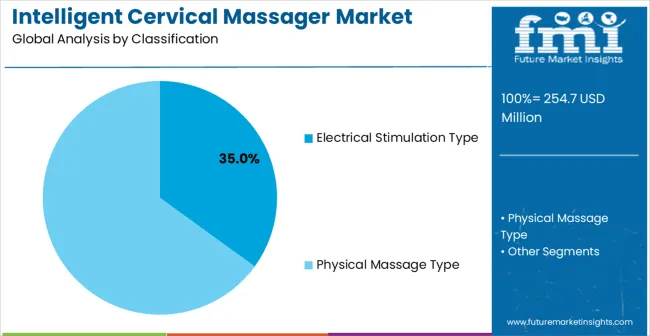
Electrical stimulation type intelligent cervical massagers are projected to account for 35% of the intelligent cervical massager market in 2025. This leading share is supported by the advanced therapeutic capabilities and precise treatment delivery that electrical stimulation technologies provide for cervical spine therapy and pain management. Electrical stimulation massagers offer targeted muscle stimulation, customizable intensity levels, and proven therapeutic effectiveness that make them preferred solutions for consumers seeking professional-grade treatment results at home. The segment benefits from established clinical validation, comprehensive therapeutic protocols, and extensive user satisfaction databases that facilitate consumer adoption and healthcare provider recommendations.
Electrical stimulation cervical massager technology continues advancing through integration of sophisticated control algorithms, enhanced safety features, and personalized treatment protocols that support diverse therapeutic needs and user preferences. The segment growth reflects increasing consumer preference for evidence-based therapeutic approaches and professional-quality treatment capabilities in home wellness devices. Manufacturers are developing next-generation electrical stimulation massagers with artificial intelligence optimization, mobile app integration, and comprehensive therapy tracking that provide personalized treatment experiences while ensuring optimal therapeutic outcomes and user safety.
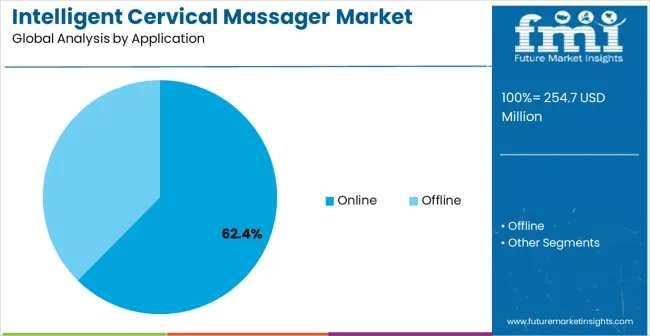
Online sales channels are expected to represent 62.4% of intelligent cervical massager demand in 2025. This dominant share reflects the growing consumer preference for convenient online shopping, comprehensive product information access, and competitive pricing advantages that online platforms provide for wellness product purchases. Modern consumers increasingly rely on online channels for health and wellness product research, comparison shopping, and purchasing decisions that benefit from extensive product reviews, detailed specifications, and convenient home delivery. The segment benefits from expanding e-commerce infrastructure, increasing digital payment adoption, and growing consumer comfort with online health product purchases.
Online sales channel transformation toward enhanced customer experience and comprehensive product support is driving significant intelligent cervical massager demand as retailers implement advanced product demonstration technologies, virtual consultation services, and comprehensive after-sales support programs. The segment expansion reflects increasing emphasis on customer education, product differentiation, and personalized shopping experiences that depend on sophisticated e-commerce platforms and comprehensive digital marketing approaches. Advanced online retail applications are incorporating augmented reality product demonstrations, artificial intelligence recommendation systems, and comprehensive health assessment tools that require sophisticated product presentation and customer engagement capabilities.
The intelligent cervical massager market is advancing steadily due to increasing neck health awareness and growing adoption of smart wellness technologies. The market faces challenges including regulatory compliance requirements for therapeutic devices, varying product quality standards, and consumer education needs regarding proper usage. Technological advancement efforts and clinical validation programs continue to influence product development and market expansion patterns.
The growing implementation of artificial intelligence and machine learning capabilities in intelligent cervical massagers is enabling personalized therapy protocols, adaptive treatment optimization, and comprehensive health monitoring that enhance therapeutic effectiveness and user experience. AI-powered massager systems provide real-time therapy adjustment, user behavior analysis, and predictive health insights that support optimal therapeutic outcomes and preventive wellness management. These technological advances enable users to achieve higher levels of therapeutic effectiveness and health monitoring while reducing treatment time and improving overall wellness management through intelligent therapy approaches.
Massager manufacturers are developing comprehensive Internet of Things connectivity and health ecosystem integration that enable seamless data sharing, comprehensive wellness tracking, and integrated health management across multiple devices and platforms. Connected massager systems provide comprehensive therapy data, health trend analysis, and integrated wellness recommendations that support holistic health management and preventive care approaches. These connectivity innovations support broader market adoption by providing enhanced value propositions and comprehensive health insights that meet evolving consumer expectations for integrated wellness solutions and comprehensive health monitoring capabilities.
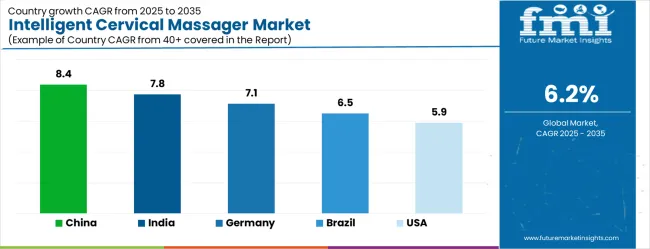
| Country | CAGR (2025-2035) |
|---|---|
| China | 8.4% |
| India | 7.8% |
| Germany | 7.1% |
| Brazil | 6.5% |
| United States | 5.9% |
| United Kingdom | 5.3% |
| Japan | 4.7% |
The intelligent cervical massager market demonstrates varied growth patterns across key countries, with China leading at an 8.4% CAGR through 2035, driven by expanding wellness market, growing health consciousness, and increasing adoption of smart health devices among urban consumers. India follows at 7.8%, supported by rising disposable incomes, growing awareness of musculoskeletal health, and expanding access to wellness technologies. Germany records 7.1% growth, emphasizing quality healthcare products, wellness culture development, and advanced therapeutic device adoption. Brazil shows steady growth at 6.5%, expanding wellness market and increasing health technology adoption. The United States maintains 5.9% growth, focusing on home healthcare solutions and smart wellness device integration. The United Kingdom demonstrates 5.3% expansion, supported by growing wellness awareness and health technology adoption. Japan records 4.7% growth, leveraging technological innovation and precision healthcare device manufacturing.
The report covers an in-depth analysis of 40+ countries with top-performing countries highlighted below.
The intelligent cervical massager market in China is projected to expand at the highest growth rate with a CAGR of 8.4% through 2035, driven by rapidly expanding wellness market, growing health consciousness among urban populations, and increasing adoption of smart health devices for preventive care management. The country's comprehensive digital health ecosystem includes extensive e-commerce infrastructure, mobile payment integration, and consumer health awareness campaigns that support intelligent massager adoption across diverse demographic segments. Major technology companies and healthcare device manufacturers are developing comprehensive product portfolios that combine traditional therapeutic approaches with advanced technology integration. Rising disposable incomes and growing emphasis on work-life balance are creating substantial demand for convenient home wellness solutions. Government initiatives promoting healthy lifestyle and preventive healthcare are supporting consumer adoption of wellness technologies.
Revenue from intelligent cervical massagers in India is projected to grow at a CAGR of 7.8%, supported by rising disposable incomes, growing awareness of musculoskeletal health issues, and increasing adoption of modern wellness technologies across urban and semi-urban populations. The country's expanding middle class and growing technology adoption are driving demand for intelligent health devices that provide convenient therapeutic solutions while offering advanced features and comprehensive health monitoring capabilities. Government initiatives promoting digital health and wellness awareness are creating favorable conditions for smart health device adoption. Educational institutions and healthcare organizations are developing awareness programs that support consumer understanding of preventive healthcare approaches. International companies are establishing distribution networks that support product availability and consumer education across diverse regional markets.
Demand for intelligent cervical massagers in Germany is expanding at a CAGR of 7.1%, supported by the country's strong wellness culture, emphasis on quality healthcare products, and comprehensive therapeutic device adoption across diverse consumer segments. German consumers are implementing sophisticated wellness solutions that meet stringent quality standards while supporting comprehensive health management and preventive care approaches. The country's advanced healthcare system and strong consumer health awareness are driving significant demand for clinically validated therapeutic devices. Research institutions are collaborating with manufacturers to develop evidence-based wellness solutions that maintain German quality and effectiveness standards. Advanced retail infrastructure is facilitating product accessibility through comprehensive distribution networks and professional consultation services.
Revenue from intelligent cervical massagers in Brazil is growing at a CAGR of 6.5%, driven by expanding wellness market, growing health consciousness, and increasing adoption of modern therapeutic technologies across diverse consumer demographics. Brazilian consumers are investing in wellness solutions that enhance health management and provide convenient therapeutic options while supporting active lifestyle maintenance and health optimization. Government programs promoting health awareness and preventive care are facilitating access to wellness technologies and consumer education. Regional retail networks are developing specialized wellness product categories that support consumer access and product education. Economic development is creating opportunities for premium wellness product adoption across expanding middle-class demographics.
The intelligent cervical massager market in the United States is anticipated to grow at a CAGR of 5.9%, driven by growing emphasis on home healthcare solutions, increasing adoption of smart wellness devices, and comprehensive integration with digital health ecosystems and wellness management platforms. American consumers are implementing advanced therapeutic solutions that support health optimization while providing convenient alternatives to traditional healthcare approaches and professional therapy services. The healthcare industry is driving significant demand for validated therapeutic devices that complement clinical treatment protocols and support patient self-management. Technology companies are developing comprehensive wellness ecosystems that integrate multiple health monitoring and therapeutic devices. Regional wellness trends are supporting consumer adoption of preventive health management approaches.
Demand for intelligent cervical massagers in the United Kingdom is forecasted to expand at a CAGR of 5.3%, supported by growing wellness awareness, increasing health technology adoption, and comprehensive emphasis on preventive healthcare approaches across diverse consumer demographics. British consumers are investing in wellness solutions that support health optimization while providing convenient access to therapeutic interventions and comprehensive wellness monitoring. The country's established healthcare infrastructure is facilitating wellness technology adoption through professional recommendations and consumer education programs. Government initiatives supporting health innovation are creating favorable conditions for advanced wellness device development and adoption. Advanced retail networks are providing comprehensive product support and consumer consultation services.
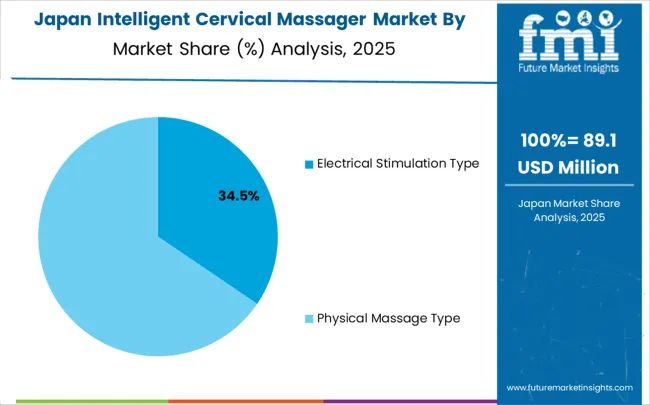
Revenue from intelligent cervical massagers in Japan is projected to grow at a CAGR of 4.7%, supported by technological innovation capabilities, precision healthcare device manufacturing expertise, and comprehensive emphasis on health optimization and wellness management across diverse consumer applications. Japanese manufacturers are implementing sophisticated wellness solutions that demonstrate superior performance characteristics while supporting various therapeutic applications requiring precision and reliability. The country's advanced technology sector is driving demand for intelligent wellness devices that incorporate cutting-edge features and comprehensive health monitoring capabilities. Collaborative research programs between technology companies and healthcare institutions are developing innovative therapeutic solutions that maintain Japan's competitive advantage in global wellness technology markets. Quality management systems and continuous improvement principles are driving adoption of wellness devices that enhance health optimization and therapeutic effectiveness. Advanced materials research is enabling development of next-generation therapeutic devices that provide enhanced performance characteristics and comprehensive user experience.
The intelligent cervical massager market in Europe is projected to grow from USD 69 million in 2025 to USD 126 million by 2035, registering a CAGR of 6.2% over the forecast period. Germany is expected to maintain its leadership with 32.4% market share in 2025, projected to grow to 33% by 2035, supported by its strong wellness culture and advanced healthcare technology adoption. France follows with 20% market share in 2025, expected to reach 20.4% by 2035, driven by growing consumer health awareness and wellness product adoption.
The Rest of Europe region is projected to maintain stable share at 18.6% throughout the forecast period, attributed to increasing wellness product adoption in Eastern European countries and expanding health technology awareness. United Kingdom contributes 15.7% in 2025, projected to reach 15.2% by 2035, supported by growing home healthcare adoption and wellness technology integration. Italy maintains 13.2% share in 2025, expected to grow to 14.5% by 2035, while other European countries demonstrate steady growth patterns reflecting regional wellness development and health technology adoption trends.
The intelligent cervical massager market is characterized by competition among specialized wellness device manufacturers, healthcare technology companies, and consumer electronics providers. Companies are investing in advanced therapeutic technologies, smart connectivity features, comprehensive mobile applications, and clinical validation programs to deliver effective, convenient, and reliable cervical massage solutions. Strategic partnerships, technological innovation, and market expansion initiatives are central to strengthening product portfolios and market presence.
AVAIH, China-based, offers comprehensive intelligent cervical massager solutions with focus on advanced therapeutic technologies, smart connectivity features, and integrated mobile applications for personalized therapy management. Jeeback provides specialized cervical massage devices emphasizing innovative design, therapeutic effectiveness, and comprehensive user experience optimization. Naipo delivers advanced wellness solutions with focus on quality construction, therapeutic validation, and consumer satisfaction across diverse market segments.
Medcursor specializes in therapeutic massage devices with emphasis on clinical effectiveness and professional-quality therapeutic outcomes. InvoSpa focuses on premium wellness solutions with advanced technology integration and comprehensive therapeutic capabilities. RENPHO provides comprehensive wellness device portfolios with smart connectivity and integrated health monitoring. Other key players including Bob and Brad, iNeck, Beurer, HoMedics, Comfier, OSIM, LG, and various Chinese manufacturers including Pra.L, Xiaomi, Breo, Xpudding, and GAX contribute specialized expertise and diverse technical capabilities across global and regional markets.
| Item | Value |
|---|---|
| Quantitative Units (2025) | USD 255 million |
| Product Type | Electrical Stimulation Type and Physical Massage Type |
| Sales Channel | Online and Offline |
| Regions Covered | North America, Europe, East Asia, South Asia & Pacific, Latin America, Middle East & Africa |
| Countries Covered | United States, Canada, United Kingdom, Germany, France, China, Japan, South Korea, India, Brazil, Australia and 40+ countries |
| Key Companies Profiled | AVAIH, Jeeback, Naipo, Medcursor, InvoSpa, RENPHO, Bob and Brad, iNeck, Beurer, HoMedics, Comfier, OSIM, LG, Pra.L, Xiaomi, Breo, Xpudding, GAX |
| Additional Attributes | Dollar sales by product type and sales channel segments, regional demand trends across North America, Europe, and Asia-Pacific, competitive landscape with established wellness device manufacturers and emerging technology providers, buyer preferences for electrical stimulation versus physical massage technologies, integration with mobile applications and smart health ecosystems, innovations in artificial intelligence capabilities and personalized therapy protocols, and adoption of Internet of Things connectivity and comprehensive health monitoring features for enhanced therapeutic effectiveness and wellness management optimization. |
The global thermal insulation materials for optical fibers market is estimated to be valued at USD 101.1 million in 2025.
The market size for the thermal insulation materials for optical fibers market is projected to reach USD 191.5 million by 2035.
The thermal insulation materials for optical fibers market is expected to grow at a 6.6% CAGR between 2025 and 2035.
The key product types in thermal insulation materials for optical fibers market are glass fiber insulation materials, ceramic fiber insulation materials, polyimide foam materials, aerogel insulation materials and other.
In terms of application, optical fiber composite insulated cables segment to command 42.0% share in the thermal insulation materials for optical fibers market in 2025.






Our Research Products

The "Full Research Suite" delivers actionable market intel, deep dives on markets or technologies, so clients act faster, cut risk, and unlock growth.

The Leaderboard benchmarks and ranks top vendors, classifying them as Established Leaders, Leading Challengers, or Disruptors & Challengers.

Locates where complements amplify value and substitutes erode it, forecasting net impact by horizon

We deliver granular, decision-grade intel: market sizing, 5-year forecasts, pricing, adoption, usage, revenue, and operational KPIs—plus competitor tracking, regulation, and value chains—across 60 countries broadly.

Spot the shifts before they hit your P&L. We track inflection points, adoption curves, pricing moves, and ecosystem plays to show where demand is heading, why it is changing, and what to do next across high-growth markets and disruptive tech

Real-time reads of user behavior. We track shifting priorities, perceptions of today’s and next-gen services, and provider experience, then pace how fast tech moves from trial to adoption, blending buyer, consumer, and channel inputs with social signals (#WhySwitch, #UX).

Partner with our analyst team to build a custom report designed around your business priorities. From analysing market trends to assessing competitors or crafting bespoke datasets, we tailor insights to your needs.
Supplier Intelligence
Discovery & Profiling
Capacity & Footprint
Performance & Risk
Compliance & Governance
Commercial Readiness
Who Supplies Whom
Scorecards & Shortlists
Playbooks & Docs
Category Intelligence
Definition & Scope
Demand & Use Cases
Cost Drivers
Market Structure
Supply Chain Map
Trade & Policy
Operating Norms
Deliverables
Buyer Intelligence
Account Basics
Spend & Scope
Procurement Model
Vendor Requirements
Terms & Policies
Entry Strategy
Pain Points & Triggers
Outputs
Pricing Analysis
Benchmarks
Trends
Should-Cost
Indexation
Landed Cost
Commercial Terms
Deliverables
Brand Analysis
Positioning & Value Prop
Share & Presence
Customer Evidence
Go-to-Market
Digital & Reputation
Compliance & Trust
KPIs & Gaps
Outputs
Full Research Suite comprises of:
Market outlook & trends analysis
Interviews & case studies
Strategic recommendations
Vendor profiles & capabilities analysis
5-year forecasts
8 regions and 60+ country-level data splits
Market segment data splits
12 months of continuous data updates
DELIVERED AS:
PDF EXCEL ONLINE
Intelligent Touch Screen Cash Register Market Size and Share Forecast Outlook 2025 to 2035
Intelligent Road Test Instruments Market Size and Share Forecast Outlook 2025 to 2035
Intelligent Driving Technology Solution Market Size and Share Forecast Outlook 2025 to 2035
Cervical Pillow Market Forecast and Outlook 2025 to 2035
Intelligent Completion Market Size and Share Market Forecast and Outlook 2025 to 2035
Intelligent Rubber Tracks Market Size and Share Forecast Outlook 2025 to 2035
Intelligent Garment Hanging Conveyor System Market Size and Share Forecast Outlook 2025 to 2035
Intelligent Rotary Kiln Monitoring Systems Market Size and Share Forecast Outlook 2025 to 2035
Intelligent Multifunctional Laser Bird Repeller Market Size and Share Forecast Outlook 2025 to 2035
Intelligent Platform Management Interface (IPMI) Market Size and Share Forecast Outlook 2025 to 2035
Cervical Dysplasia Treatment Market Size and Share Forecast Outlook 2025 to 2035
Intelligent Flow Meter Market Size and Share Forecast Outlook 2025 to 2035
Intelligent Lighting Control Market Size and Share Forecast Outlook 2025 to 2035
Intelligent Enterprise Data Capture Software Industry Analysis in Japan Size and Share Forecast Outlook 2025 to 2035
Intelligent Vending Machine Market Insights – Demand, Size & Industry Trends 2025–2035
Intelligent Transportation System Market Analysis - Size, Share, and Forecast Outlook 2025 to 2035
Intelligent Virtual Store Design Solution Market Size and Share Forecast Outlook 2025 to 2035
Intelligent Enterprise Data Capture Software Market Size, Growth, and Forecast 2025 to 2035
Intelligent Fencing Market Size and Share Forecast Outlook 2025 to 2035
Cervical Cancer Treatment Market Size and Share Forecast Outlook 2025 to 2035

Thank you!
You will receive an email from our Business Development Manager. Please be sure to check your SPAM/JUNK folder too.
Chat With
MaRIA